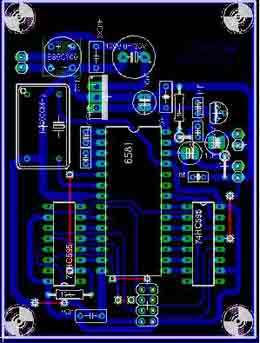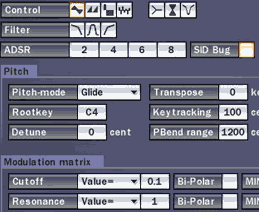SOUND INTERFACE DEVICE - THE FIRST DIGITAL SYNTH IN A COMPUTER
When the C64 was created in 1982 one of its many revolutionary new features was its
amazing sound chip. For the first time a computer could say more than just 'BEEP'
because in the C64 a computer for the first time had a built in synthesizer chip,
something found only electronic keyboards before. And so this special chip, named
SID (after Sound Interface Device), is definitely the mother of all synth chips that
we can find in any PC, Laptop and MAC today which finally made it possible for us to
create electronic music thew way we do it now.
Anybody who has heard a C64 and therefore a SID in action would state that the sound
of it is a really special one. Being a wavetable synth by principle it should sound
like standard wavetable synth which it did - and didn't. There's a certain pecularity
and crunchyness about it and many people who spent some time with a C64 (most of them
in their youth with gaming) stored that very sound in their hearts and could always
point out a SID from any other synth. What sets this special sound apart from all
other chips that followed, how a SID works in (a bit deeper detail) and the story of
its creation I will try to relate here.
CREATION OF THE SID: BOBY YANNES
The SID was designed by a young engineer named Bob Yannes, an electronic music
hobbyist who had worked with synthesizers before and who was with a company named
MOS Technology in 1981. This company was a supplier for Commodore and Yannes and his
team got the task to construct a soundchip for the upcoming C64 Homecomputer - within
a timeframe of only four months! The goal was to create a single-chip synthesizer (a
novum in that time: one chip only!) which could also be used in professional hardware
synths. The result was a big achivement but due to the highly limited time a few
things were not really perfect. But Yannes left MOS after the project and started his
own company, the well known ENSONIQ, and never had the opportunity to finish his work
with the SID. In 1986 he then designed the ENONIQ soundchip that was used in the
APPLE II and which was the first soundchip that surpassed the SID and presented the
most powerful computer synth until the mid-90ies. (Click HERE to read the full
interview with Bob Yannes, where he also explains the synth architecture in FULL
detail, so some basic knowledge might be useful!)
THE SID ARCHITECTURE
The peculiar architecture is what gives the SIDs its special sound, a result of both
brilliant engineering and the circumstances of its development. So here are the
details:
THREE VOICES and WAVFORM GENERATION
First of all the general structure is not much different from any other synth: a
waveform is generated with the oscillator, the volume of that sound is modulated with
an ADSR-envelope and the result is then sent through a programmable filter. Since
there was not much room on the chip some compromises had to be made. The first one
was the limitation to three oscillators (or voices) that could be played
simultaneously (a novum for that time) and be mixed with each other to generate more
complex sounds.
The other problem was that for a real wavetable synthesis there actually had to be a
wavetable where the single waveform-samples are stored (today this wavetable
is called 'GENERAL MIDI', all the built-in instruments of your soundcard are stored
there). Since there was no room for a wavetable on the chip either the single wave-
forms (SAW, VARIABLE PULSE, TRIANGLE and NOISE) had to be generated out of some
algorhythms and are therefore rather a mathematical emulation of a sampled waveform
than a real one, which contributes highly to the 'specialness' of the SIDs sound.
The oscillators could generate frequencies up to 4000 Hz with a reasonable
resolution, for higher frequencies more than one waveform could be selected in a
voice or ring modulation could be used.
The three voices are then not mixed together in the real analogue sense but more
logically combined which produced some unpredictable results. Also the signal-to-
noise
ratio is not really perfect which gives the whole sound its well-known and
-loved
dirty quality.
ENVELOPES
The three envelope generators (each for one voice) consisted of a simple 8bit up-
down-counter out of which, with the help of some algorhythms, the actual envelope is
generated. The rates for ATTACK, DECAY, SUSTAIN and RELEASE could then be set and the
whole thing modulated the volume of the before generated waveform or the filter
cutoff frequency. The available rates for ADSR seemed a bit strange but Yannes tried
to emulate the envelopes of a SEQUENTIAL CIRCUIT PRO-1 synth, timed their values by
ear and used these experimentially found values for the SID envelope.
The filter is one of the most problematic pieces in the SID architechture, mostly
because the resistance of some transistors varied considerably with processing and
different lots of SID chips had different cutoff frequency characteristics. So a
music bit sounding great in one C64 would sound completely different in another unit!
This phenomenon is known as the 'SID Filter bug'.
But while this problem caused lots of pain for the musicians and sound designers of
the C64 era it didn't necessarily mean a major flaw. Ben Daglish, one of the heros
of that time, said when asked about the bug:
the quality of the components - accurate frequency filtering just wasn't viable on
such a small cheap (and early!) chip, so Commodore made do with what they had.
Basically, one could apply (say) a band-pass filter centered around X Hz, but X would
vary by a fair percentage from chip to chip."
EXTRAS
In addition to the whole the revolutionary archictecture of the chip the SID had some
other nice features. First of all there were the two A/D converters that provided for
interfacing SID with potentiometers. These can be used for "paddles" in a game
environment or as front panel controls in a music synthesizer.
Furthermore the SID could process external audio signals, allowing multiple SID chips
to be daisy-chained or mixed in complex polyphonic systems.
INNOVATIONS: AUDIO ILLUSIONS and SAMPLES
Although the design of the chip was quite a feat, the true test of technology is what
people can do with it. The early musical pieces on the C64 were impressive for that
time frame, but the hidden potential of the chip wasn't heard until 1985. Composers
began to use audio "illusions" that tricked the ear into hearing more voices than the
three-voice chip actually had.
Another revolutionary step was made in 1987. By stopping an Oscillator, it was
possible to apply a DC voltage to an amp and audio could then be created by having
the microprocessor write volume on this DC in real-time. This means nothing else but
that in this way it was possible for a first time to synthesize speech or play
sampled sounds with a computer - an enourmously important discovery which is
basically the core of electronic music production today!
Until today the full potential of the chip is not completely known, mostly owing to
the fact that the SID was not fully and only faultily documented during its creation.
Remains to say that the SID chip is something like an unfinished masterpiece and that
just this very 'unfinishedness', the built-in compromises, bugs and flaws, is
basically one of its biggest feartures, greatly adding to the charm and uniquness of
this nice piece of technology.
Click to the next part of the section to read how musicians used the SID to compose
music, who were the pioneers and to hear some classic 8bit-madness in stereo!











